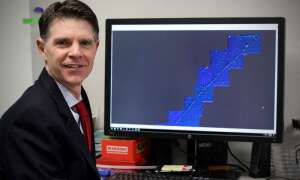Scientists develop new imaging technique that could map DNA mutations
by Lauren Dubinsky, Senior Reporter | November 29, 2017
Business Affairs

Jason Reed
Courtesy of John Wallace
at VCU Massey Cancer
Courtesy of John Wallace
at VCU Massey Cancer
Scientists at Virginia Commonwealth University developed a new imaging technique that may be able to map DNA mutations and transform the way certain diseases are diagnosed and treated.
The technique combines high-speed atomic force microscopy and chemical bar coding to map DNA almost as accurately as DNA sequencing.
"Current 'genomic medicine' is not widely available in community hospitals and other non-urban settings," Jason Reed, physicist at the university, told HCB News. "The unfortunate fact is that patients from rural areas, or those from lower income groups without access to the most recent molecular methods, will not receive the best available diagnostics."

 Biomedical imaging techniques like fluorescence in situ hybridization can evaluate DNA at a resolution of several hundred thousand base pairs, but the new technique can map DNA to a resolution of tens of base pairs while also creating images up to a million base pairs in size.
Biomedical imaging techniques like fluorescence in situ hybridization can evaluate DNA at a resolution of several hundred thousand base pairs, but the new technique can map DNA to a resolution of tens of base pairs while also creating images up to a million base pairs in size.
The chemical bar coding application leverages an enzyme called CRISPR that was programmed to cut DNA at precise locations that the cell can repair on its own. The team changed the chemical reaction conditions of the enzyme so it only sticks to the DNA and doesn’t actually cut it.
CRISPR is ideal for the bar coding application because it’s physically bigger than the DNA molecule and 90 percent efficient at bonding to it. Since it’s easy to see CRISPR enzymes, genetic mutations can be seen among the patterns in DNA.
In a study published on Tuesday in Nature Communications, the team of scientists mapped genetic translocations present in lymph node biopsies of lymphoma patients. The translocations occur when one section of DNA is copied and pasted to the wrong place in the genome, and they are particularly common in blood cancers like lymphoma.
There are many uses for this new imaging technique, but the team has chosen to focus on medical applications. They are currently developing software based on existing algorithms that can assess patterns in sections of DNA up to and over a million base pairs in size.
They hope this will translate into a shoebox-sized machine for pathology labs that assists with diagnosing and treating diseases linked to genetic mutations.
The technique combines high-speed atomic force microscopy and chemical bar coding to map DNA almost as accurately as DNA sequencing.
"Current 'genomic medicine' is not widely available in community hospitals and other non-urban settings," Jason Reed, physicist at the university, told HCB News. "The unfortunate fact is that patients from rural areas, or those from lower income groups without access to the most recent molecular methods, will not receive the best available diagnostics."
We repair MRI Coils, RF amplifiers, Gradient Amplifiers and Injectors.
MIT labs, experts in Multi-Vendor component level repair of: MRI Coils, RF amplifiers, Gradient Amplifiers Contrast Media Injectors. System repairs, sub-assembly repairs, component level repairs, refurbish/calibrate. info@mitlabsusa.com/+1 (305) 470-8013

The chemical bar coding application leverages an enzyme called CRISPR that was programmed to cut DNA at precise locations that the cell can repair on its own. The team changed the chemical reaction conditions of the enzyme so it only sticks to the DNA and doesn’t actually cut it.
CRISPR is ideal for the bar coding application because it’s physically bigger than the DNA molecule and 90 percent efficient at bonding to it. Since it’s easy to see CRISPR enzymes, genetic mutations can be seen among the patterns in DNA.
In a study published on Tuesday in Nature Communications, the team of scientists mapped genetic translocations present in lymph node biopsies of lymphoma patients. The translocations occur when one section of DNA is copied and pasted to the wrong place in the genome, and they are particularly common in blood cancers like lymphoma.
There are many uses for this new imaging technique, but the team has chosen to focus on medical applications. They are currently developing software based on existing algorithms that can assess patterns in sections of DNA up to and over a million base pairs in size.
They hope this will translate into a shoebox-sized machine for pathology labs that assists with diagnosing and treating diseases linked to genetic mutations.
You Must Be Logged In To Post A CommentRegisterRegistration is Free and Easy. Enjoy the benefits of The World's Leading New & Used Medical Equipment Marketplace. Register Now! |
|










